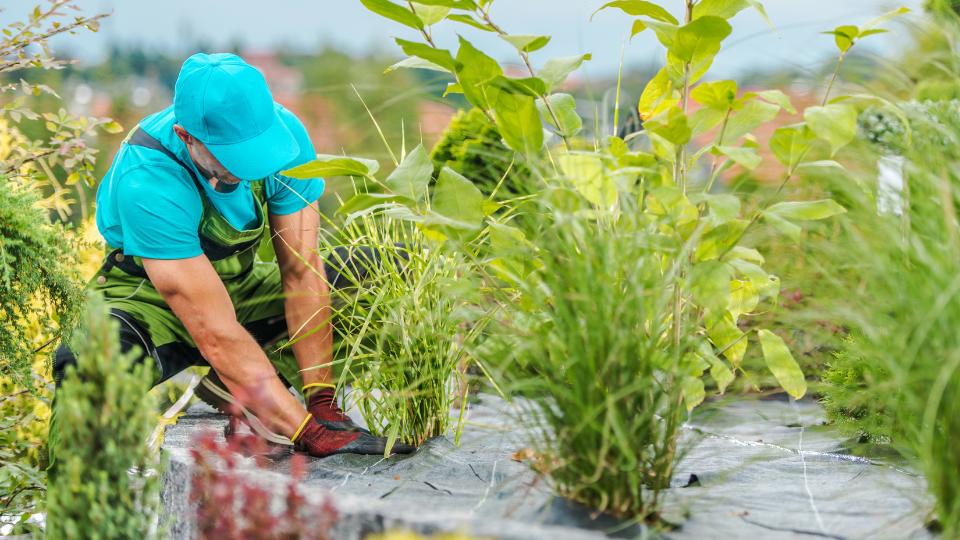Maintaining a Water-wise Landscape

A common misconception is that water-wise landscapes require more maintenance hours than other landscape types. To test this idea, the City of Santa Monica partnered with Santa Monica College and the Metropolitan Water District of Southern California to create the garden\garden project. The front yards of two neighboring homes were landscaped. One using the design principles covered in the “Water-Wise Landscape Implementation” fact sheet, and the other with non-water-wise landscape practices, which included a large area of high-water-use lawn. The side-by-side landscape comparison provided a unique introduction to the benefits of water-wise landscaping practices. A nine-year case study comparing the two landscapes showed that the water-wise landscape used 83% less water; generated 56% less green waste; and required 68% less maintenance than the high-water-use lawn dominated landscape (Figure 1). View the project summary
While the time required to maintain the space is less, the type of maintenance is different. It’s much easier to train someone to mow a lawn than differentiate a weed from a desirable plant. When considering the water shortages facing the Intermountain West, the extra training effort is worth the long-term impacts in terms of both water conservation and fewer maintenance hours. The goal of this fact sheet is to simplify and improve how water-wise landscapes are maintained. This publication primarily focuses on irrigation scheduling and briefly discusses weed management and fertilizing, which are covered in more detail in the complement “Water-Wise Landscaping: Plant Maintenance''.
Weed Control
Controlling weeds is the most time-consuming aspect of any landscape, but the lack of living ground cover, i.e., lawn, makes it more difficult in a water-wise landscape.
Mulch
Landscape fabric. Avoid using landscape fabric under mulch materials. If weeds are properly controlled before mulch application, a barrier between the soil and the mulch material is not necessary. If weeds are not properly controlled prior to application, cardboard is a better option. The barriers (cardboard and landscape fabrics) successfully stop weeds from growing up from below the barrier but do not stop weeds from growing on top of the barrier. The landscape fabrics and cardboard both decrease water infiltration into the soil, but the cardboard is short-term as it quickly decomposes, adding organic matter to the soil. Fabrics decrease water infiltration long-term, decrease oxygen exchange within the soil, and makes it difficult to add soil amendments and fertilizer to the root zone of the plants.
Upkeep. A mulch layer of 2-4 inches is recommended. Shredded bark and other materials that break down over time will need to be replenished as they decompose. While it’s not as convenient as a rock mulch, the decomposing organic material improves the soil overtime.
Herbicides
Mulches help to control weeds in the landscape, but they are not a silver bullet. Hand pulling and/or herbicides (weed killer) are needed to maintain an attractive space. When using herbicides, always read the product labels and wear the appropriate personal protective equipment.
Pre-emergent herbicides. Pre-emergent herbicides are an effective tool. They stop weeds from emerging or establishing, hence the name. If applied appropriately, they will not damage desirable plants that are already established in the landscape.
Post-emergent herbicides. Post-emergent herbicides are used to kill plants after they emerge. Some are selective, meaning they only kill a specific plant type, like a broadleaf weed killer (non-grass type). Some are nonselective, meaning they kill everything. Roundup (glyphosate) is a common example of a nonselective herbicide.
Fertilizers
With the exception of the lawn, vegetable gardens, and fruit trees, most landscapes rarely need fertilizer. Keep an eye out for nutrient deficiencies, like iron choloris and apply nutrients as needed.
Irrigation Scheduling
An appropriate irrigation system design and schedule are the first steps to maintaining a healthy landscape. Irrigation design was covered in the “Water-Wise Landscape Implementation” fact sheet and will briefly be discussed here. Appropriate irrigation amounts and frequency will be the main focus of this section. In order to develop an effective irrigation schedule, there are several questions to answer:
- How much water needs to be applied (Water Need)?
- How often do I need to run the irrigation system (Irrigation Frequency)?
- How long do I need to run the irrigation system (Irrigation Run Time)?
Water budgets
A water budget is a tool used to estimate or determine the water needs of a landscape. It is useful to access historic ET data from sources like the USU Climate Center to estimate seasonal irrigation needs and develop a tentative irrigation schedule. While the schedule will need to be adjusted based on real-time weather conditions, it is a useful baseline. Similar to ET, there are several factors that impact the water budget: - Evapotranspiration (ET). As previously mentioned, the Utah Climate Center has a series of weather stations throughout the state that gather ET data. These weather stations calculate a reference ET (ETo), or water need, of a single plant type, cool-season turfgrass. The calculated water need of this single plant type is a reference point for calculating the water need of other plant types. ET data collected from weather stations is called the reference ET or ETo.
- Plant type. Plants are commonly categorized by water need, i.e., low, moderate, or high water use, but what does that really mean? When a plant tag or catalog description refers to a plant as a low or high water user, they are comparing the water need of that plant to the water need of the reference plant (cool-season turfgrass), aka reference ET. Reference ET is a tool used to calculate the water needs of other plants. For example, low-water-use plants require 10-30% of the water that the reference plant does. If the historic reference ET or ETo for the month of July is 10 inches, low-water-use plants will need 10-30% of this amount, or 1-3 inches. Figure 2 describes plant water needs compared to reference ET. These are broad categories. When the water need of an individual plant has been studied and a specific water requirement has been determined, it is referred to as a plant factor or crop coefficient. For example, research has determined that the Sedum acre (aka stonecrop) has a plant factor of 0.25, meaning that Sedum needs 25% of the water that the reference crop needs, ETo. If a specific plant factor is not known, it is wise to start in the middle of the recommendation and adjust up or down as needed.
- Irrigated area. When calculating a water budget in inches of water needed, the size of the area being irrigated is not a factor (water need = ETo X the plant factor). When converting inches to gallons, discussed below, the size of the area being irrigated plays a role. The goal of the irrigator is to wet 50-60% of the plant’s root zone. This is typically accomplished by placing the irrigation system within the drip line of the plant. The drip line is the area beneath the plant canopy. For columnar type plants (tall and slender), this is not an effective method. Rule of thumb: there is a correlation between root spread and plant height. For example, if a tree is 15 feet tall, the roots spread 15 feet wide on either side.
Converting inches to gallons
The reference ET is calculated in inches, which is useful when irrigating with a sprinkler system but not as applicable when using drip irrigation. To convert inches needed to gallons needed, multiply the inches needed by the size of the area that is being irrigated and 0.623, which is a conversion factor that converts inches to gallons. It takes 0.623 gallons of water to apply 1 inch of water to 1 square foot of space. Gallons Needed = Inches needed X Irrigated area X 0.623
Practical Water Budget Example
Let’s pretend we live in Cedar City, UT and we have a planting area with 3 established low-water-use perennials. Each plant is roughly 18” tall and wide. After accessing the data available on the USU Climate Center website we determine that the average historic reference ET for the month of June is 7”. Here’s what we know:
Water Budget Calculations:
- Water need in Inches = ETo X the plant factor
- Gallons Needed = Inches needed X Irrigated area X 0.623
- Reference ET = 7
- Plant type = low water use (10-30% of ETo)
- Irrigated area = 1.75 ft2 (calculate the area of a circle with an 18” diameter)
Plugging in the Numbers
Reminder: low water use plants need 10-30% of the water that the reference crop requires. If you’re not sure what the specific plant factor is, start in the middle and adjust up or down as needed.
Math tip: 10%=.10, 20%=.20, 30%=.30, etc.
Water Need in Inches = ETo X the plant factor
Water Need in Inches = 7” x .20
Water Need in Inches = 1.4”
Gallons Needed = Inches needed X Irrigated area X 0.623
Gallons Needed = 1.4” x 1.75 ft2 x 0.623
Gallons Needed = 1.5 Gallons
Summary
Each of the three low water use perennials in this example will need roughly 1.5 gallons of water during the average June in Cedar City UT. Next let’s determine if we should divide the water requirement of 1.5 gallons into multiple irrigation events over the course of the month and if so, how much water we should apply with each irrigation.
One of the main reasons plants die in the landscape is due to overwatering. It is rare to have a situation where daily watering is necessary, yet it’s a common practice. Once the water need is calculated, determining irrigation frequency can be as simple as digging a small hole to inspect the soil moisture content. The soil surface may look dry, but digging down 2-3 inches may tell a different story. If the top few inches of soil are dry, it’s time to water. If the soil feels moist, wait a couple of days and check again.
A more calculated approach to determining irrigation frequency is to utilize ET data and consider the plant classification, depth of the plant’s root system, and soil type. Plants with a higher plant factor, covered above, will require more frequent irrigations when compared to those with a lower plant factor. The soil type determines how much water the soil can hold, which affects the amount of water that can be applied with each irrigation as well as the frequency of irrigation.
Irrigation depth
Figure 3 provides a target watering depth based on plant type. It will take a larger plant with an extensive root system, like a tree, longer to deplete half of the water from the top 2 feet of soil than it will take a lawn to deplete half of the water from the top 6 inches of soil, which is why the lawn is irrigated more frequently but with less water than trees.
Depletion rate
The goal when watering the landscape is to irrigate once 50% of the available water in the soil has been used by the plant and lost through evaporation. The previously mentioned example of digging a small hole to evaluate soil moisture content is effective but not always practical. As discussed previously, soils covered with a 2- to 4-inch layer of mulch will lose less water through evaporation than those without.
Soil type
Water holding capacity varies by soil texture. Sandy soil types have a low water holding capacity and will need more frequent irrigation than those with higher clay content. The water needs of the plant do not change, but the irrigation frequency will. Figure 4 (Figure 4. Available Water Capacity by Soil Texture. Source: noble.org) illustrates the water holding capacities for different soil types. For an accurate soil texture classification, soil samples can be mailed to the Analytical Laboratories at Utah State University.
Practical Example
We previously determined that low-water-use perennials need roughly 1.5 gallons of water during the average June in Cedar City UT. Soil test results determined that we have a silty clay loam soil type that can hold roughly 2” of water for every foot of soil. Here’s what we know:
- Irrigation Depth. The majority of our perennial plant roots are growing in the top 12” of soil Figure 3. This is our target irrigation depth.
- Soil Type. Our soil type can hold 2” of water in 12” of soil, which is our target irrigation depth. The soil does not have the ability to hold more than 2” of water within this root zone.
- Depletion rate. The goal when watering the landscape is to irrigate once 50% of the available water in the soil has been used by the plant and lost through evaporation. In this example, our goal is to irrigate once 1” (50% of 2”) has been lost through evapotranspiration.
- Using our math skills we can determine that 1 gallon of water will wet our ideal irrigation area of 1.75 ft2 with 1” of water.
Gallons Needed = 1” x 1.75 ft2 x 0.623
Gallons Needed = 1 Gallons
Summary
Our water budget calculations in the previous section determined that we need 1.5 gallons of water during the month of June. Based on soil type, irrigated area, depth, and depletion rate, we determined that we need to apply 1 gallon of water with each irrigation event. In this situation, applying one gallon of water every 15-20 days would be appropriate.
The application rate of 1 gallon of water with each irrigation event will not change unless the soil type changes. The frequency may need to be adjusted based on real-time weather conditions.
Once the water need and irrigation frequency are determined the final piece of the puzzle is calculating how long to run the irrigation system. In order to accomplish this, we need to know how quickly our system applies water.
Precipitation rate
Precipitation rate is the speed that water is applied to the area that is being irrigated. Drip systems are fairly easy to calculate. For example, if you have 1, 1 gallon/hr emitter that waters a plant, that plant is receiving 1 gallon of water per hour. If you have 10, 1 gallon/hr emitters that are watering a plant, that plant is receiving 10 gallons of water per hour.
Sprinklers systems are more complicated to calculate. USU, in partnership with water districts and municipalities throughout the state, offer free water checks to help. The Water Check Program sends trained technicians to your home or business to perform a water audit of your irrigation system. Their goal is to determine the precipitation rate of your system which they then use to calculate how long you should run your system. This information can then be used to program a Smart Irrigation Controller or translated into a runtime and used to program your standard irrigation controller. The calculated runtime won’t change during the growing season, but the frequency of irrigation will change as ET changes (remember, ET is affected by weather conditions). Find more information on lawn watering, water check, and statewide resources in the Watering the Landscape: Make it Easier with Evapotranspiration (ET) fact sheet.
Practical Example
We previously determined that low-water-use perennials need roughly 1.5 gallons of water during the average June in Cedar City, UT. Based on soil type, irrigated area, depth, and depletion rate, we determined that we need to apply 1 gallon of water with each irrigation event. In this situation, applying one gallon of water every 15-20 days would be appropriate, but now we haven’t determined how long to run our system.
The short answer, it depends. Drip irrigation would be the appropriate method for irrigating the perennials. Run time will be dependent on the size and number of emitters used. For example:
1, 2 gal/hr emitter = 30 minute run time
2, 1 gal/hr emitters = 30 minute run time
1, 1 gal/hr emitter = 1 hour run time
1, .5 gal/hr emitter = 2 hour run time
Summary
To tie these concepts together, a general irrigation schedule and water need for perennials is outlined in figure 5. This schedule follows the examples used throughout this publication. It is based on historic ET data and is an appropriate guide for most of the state. Warmer locations, like St. George, Kanab, and Moab will have a higher water requirement, but could use the guide as a starting point. The amount of water applied with each irrigation will depend on your soil type (a water holding capacity of 2” of water in 1’ of soil was used). As highlighted in figure 4, different soil types have the ability to hold different amounts of water. Reach out to your local Extension office for help modify the schedule to meet your conditions.
Final Thoughts
In some situations, hand watering plants is the best option. One common example is when the irrigation system is designed poorly and trees are on the same irrigation zone as plants with a shallow root system (i.e., lawn) meaning they both get watered at the same time. Each of these plant types have a different water requirement, the lawn needing frequent shallow irrigations that maintain soil moisture to a depth of 6 inches and the tree needing infrequent deep irrigations that maintain soil moisture to a depth of 18-24 inches (Figure 3). In this situation, it’s best to remove or stop the flow of water to the trees and irrigate by hand as needed.
For additional resources, please visit the “Water-Wise Landscaping: Practical Turfgrass Areas” and “Basic Turfgrass Care” fact sheets, as well as the “Perform Your Own Water Check” YouTube video.
References
- McMillen, M. (2013). The effect of mulch type and thickness on the soil surface evaporation rate.
Authors
Related Research


 Utah 4-H & Youth
Utah 4-H & Youth



